
Carl Zeiss Distagon T* 2/35 ZF
My usage
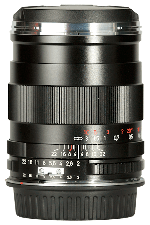 Since I decided to move from Canon EOS 5D
to Canon EOS 1D Mark III I needed a new normal lens since
I could no longer use my Leica Summicron-R 50mm f/2.0 as my
normal lens since it's field of view on 1.3x crop is same as 65mm lens on full frame, a
little long for my taste. 35mm field of view in 1.3x crop is same as 46mm lens would be
on fullframe, therefore this lens is my normal lens on 1.3x crop format. Since I decided to move from Canon EOS 5D
to Canon EOS 1D Mark III I needed a new normal lens since
I could no longer use my Leica Summicron-R 50mm f/2.0 as my
normal lens since it's field of view on 1.3x crop is same as 65mm lens on full frame, a
little long for my taste. 35mm field of view in 1.3x crop is same as 46mm lens would be
on fullframe, therefore this lens is my normal lens on 1.3x crop format.
Most important aspect of normal lens (to me) is that it produces neutral perspective.
With this lens I use perspective as main element to create the 3d feeling to images I take
with, and typically it also needs help from well controlled bokeh, not too blurry and not
too sharp and not distractive.
Naturally this lens is also used to all kind of landscape photography. Then I need all
the sharpness and microcontrast I can get out from the lens, and this lens delivers!
Image quality
2008-03-01: In order to give final verdict more photographs are needed to be taken. This
section is under construction.
Sharpness and Contrast
Based on photos I have taken I have no reason to doubt that the measured MTF charts would
not be as Zeiss has them measured.
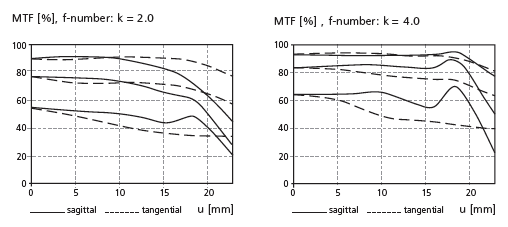
According to Zeiss (underline parts different than in Canon's MTFs): "The Modulation
Transfer (MTF) as a function of image height (u) and slit orientation (sagittal, tangential)
has been measured with white light at spatial frequencies of R = 10, 20 and
40 cycles/mm."
Handling and usage
Focusing from infinity to 0.44 meter is about 360 degrees rotation. Manual focus feeling
is very tight and in some situations I would prefer to have less resistance when turning
the manual focus ring. Manual focusing is very accurate and it's very easy to achieve
accurate focus with live view. For Canon users the focus ring also turns into wrong direction;
e.g. all the way to clockwise is infinity and not minimum focus distance
Aperture is can be selected 1/2 stop intervals. When using viewfinder and manually stopping
down it's easy to calculate "clicks" from wide open to determine the aperture into which lens
is stopped down. Only problem with setting aperture is that the lens barrel is quite wide
(wider than aperture ring) and aperture ring is between lens barrel and camera and in some situations it wasn't easy to adjust aperture, specially with gloves.
Lens hood protects front lens element quite well physically, but not from sun and other
light sources. This lens would definitely benefit from scalloped hood. Zeiss lens caps are
not very good to operate and I have replaced them with Nikon lens caps with have better
design.
Circular polarizer is easy to operate even when the hood is attached to the lens. However
the hood does not protect the filter much from the sun and other light sources.
Build quality and basics
Build quality is as good as I could imagine, from different planet than Canon lenses.
Lens hood has bajonet and lens hood is made of metal, not plastic. Lens hood fits very well
to lens and can be reversed.
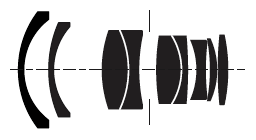 Lens dimensions with Nikon to EOS adapter and lens caps are: diameter 65mm, length 115mm,
weight 565g. Dimensions when including hood: diameter 82mm, length 162mm and weight 590g.
This lens isn't internal focusing and therefore extends when focused closer. Lens extends
about 5mm when focused to minimum focus distance 0.3m. Lens uses filter size of 58mm.
Lens dimensions with Nikon to EOS adapter and lens caps are: diameter 65mm, length 115mm,
weight 565g. Dimensions when including hood: diameter 82mm, length 162mm and weight 590g.
This lens isn't internal focusing and therefore extends when focused closer. Lens extends
about 5mm when focused to minimum focus distance 0.3m. Lens uses filter size of 58mm.
Minimum aperture is f/22. Aperture has 9 blades and aperture remains very round even at
f/22. Lens has 9 elements which are in 7 groups. Actual focal length is 35mm. Minimum
focus distance is 0.3m, which results 1:5.4 (0.18x) magnification and full frame (36mm x 24mm) coverage of 196mm x 129mm.
Summary
Pros
+
+
+
+
Cons
-
-
-
-
See photos
in my picturebank taken with this lens.
digLloyd Zeiss ZF lenses
Zeiss.com - Carl Zeiss Distagon T* 35mm f/2.0
Zeiss.com - Carl Zeiss Makro-Planar T* 100mm f/2.0
16-9.net - Test of 28mm lenses including CZ 28/2.8
Pebble Place - Carl Zeiss Planar T* 2/100
Pebble Place - Carl Zeiss Macro-Sonnar T* 2.8/100 N
SLR Lens Review - Contax Sonnar T* 2.8/135mm C/Y
SLR Lens Review - Contax Sonnar T* 2.8/85mm C/Y
SLR Lens Review - Contax Planar T* 1.7/50mm C/Y
Pebble Place - Contax Sonnar T* 2.8/135mm C/Y
Some example pictures of Zeiss lenses
pinciuc.com - samples from various lenses
Pictures of Carl Zeiss Distagon T* 2/35 ZF
Lens extends when focused
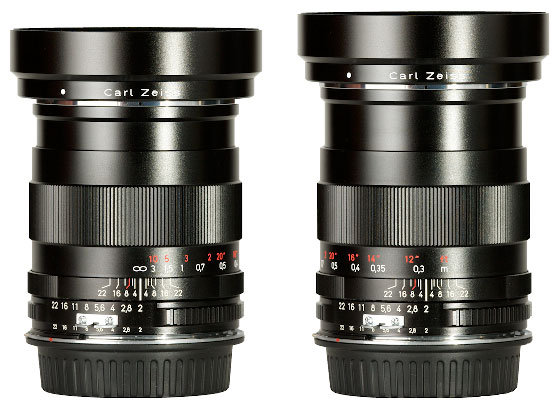
Distance from EOS lens mount (including adapter) to end of the hood is 91mm at infinity
and 96mm at minimum focus distance.
Front/side projection
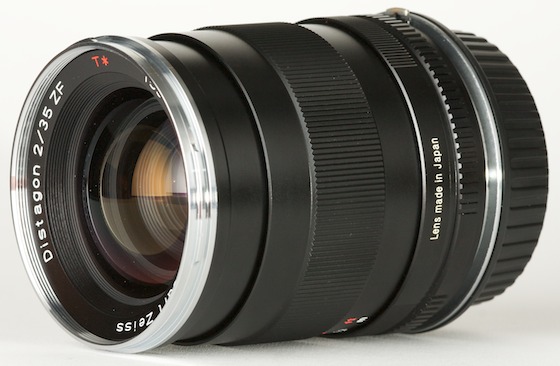
Made in Japan, unfortunately...
Carl Zeiss Distagon T* 2/35 ZF with Canon EOS 1D Mark III
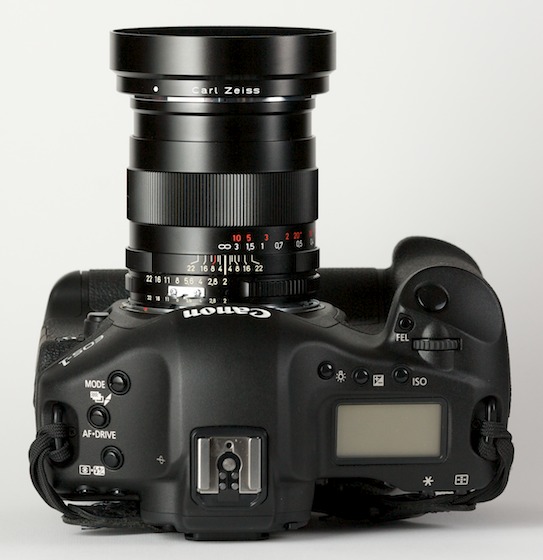
2/35 balances well with 1D Mark III
|

 Since I decided to move from
Since I decided to move from 
 Lens dimensions with Nikon to EOS adapter and lens caps are: diameter 65mm, length 115mm,
weight 565g. Dimensions when including hood: diameter 82mm, length 162mm and weight 590g.
This lens isn't internal focusing and therefore extends when focused closer. Lens extends
about 5mm when focused to minimum focus distance 0.3m. Lens uses filter size of 58mm.
Lens dimensions with Nikon to EOS adapter and lens caps are: diameter 65mm, length 115mm,
weight 565g. Dimensions when including hood: diameter 82mm, length 162mm and weight 590g.
This lens isn't internal focusing and therefore extends when focused closer. Lens extends
about 5mm when focused to minimum focus distance 0.3m. Lens uses filter size of 58mm.

